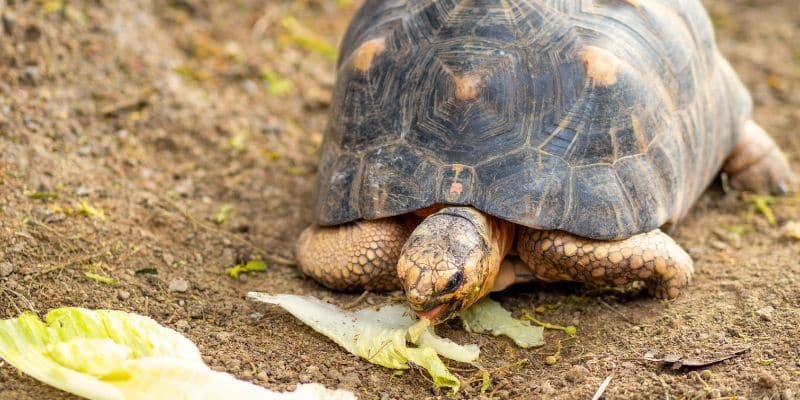
Imagine having a pet that could live for decades—like an old friend that stays with you through thick and thin. The red-footed tortoise can live for well over 50 years, making them a long-term commitment. If you’re considering bringing one into your home, understanding their growth rate and lifespan is essential. Let’s dive deeper into the world of this charming tortoise.
Understanding the Red-Footed Tortoise
The red-footed tortoise (*Chelonoidis carbonarius*) is native to the forests and grasslands of South America. With striking red or orange scales on their legs and a patterned shell, they have a unique appearance that sets them apart from other tortoises. These creatures typically weigh between 30 to 50 pounds and reach about 8 to 12 inches in length.
In the wild, red-footed tortoises play a vital role in their ecosystem. They help to disperse seeds, contributing to the growth of vegetation. They’re primarily herbivores, munching on fruits, leaves, and flowers, which makes them relatively easy to care for in captivity. If you’re thinking about adopting one, consider how their natural habits inform their care needs.
Average Lifespan of the Red-Footed Tortoise
The lifespan of a red-footed tortoise is one of its most impressive traits. In captivity, these tortoises can live to be 50 to 75 years old, sometimes even longer! This longevity makes them one of the longer-living pets you can own. Imagine having a companion who grows alongside you as you navigate through different stages of life.
Several factors influence how long a red-footed tortoise lives. Diet, habitat, and healthcare play significant roles. A balanced diet filled with nutritious greens and occasional treats is crucial. Regular check-ups with a veterinarian who specializes in reptiles can help catch any health problems early.
Growth Rate of the Red-Footed Tortoise
Now that we know they can live for decades, let’s talk about how quickly these slowpokes grow. Red-footed tortoises typically go through a noticeable growth phase in their early years. They can grow about 1 to 2 inches per year during their first few years of life. This growth slows down significantly as they reach adulthood, which usually occurs around the age of 10 to 15.
To give you an idea, a hatchling red-footed tortoise may measure about 4 inches at birth. By the time it hits its teenage years, it could reach around 8 to 10 inches in length. Once they reach maturity, growth becomes much slower, and they can stay at that size for many years.
Factors Affecting Their Growth Rate
Just like how people grow at different rates, the growth of a red-footed tortoise can vary based on several factors:
- Diet: A healthy diet rich in fruits, leafy greens, and a correct calcium-to-phosphorus ratio is vital for optimal growth.
- Habitat: Proper habitat conditions, including temperature, humidity, and space, are essential for healthy development.
- Health: Regular vet check-ups can help prevent illnesses that might stunt growth.
It’s important to create an environment that mimics their natural habitat as much as possible. This means providing adequate humidity, a warm basking area, and plenty of room to roam.
Signs of a Healthy Red-Footed Tortoise
Keeping an eye on your tortoise’s growth helps ensure it stays healthy. Here are some signs that indicate your red-footed tortoise is growing well:
- Consistent Growth: If your tortoise is steadily gaining size without any sudden drops or pauses, that’s a good sign.
- Bright Eyes and Clear Skin: Healthy tortoises have alert eyes and smooth skin. Dullness might signal health issues.
- Active Behavior: A tortoise that explores its environment and enjoys basking is generally healthier.
When you see these signs, you can rest easy knowing you’re doing a good job caring for your shelled friend.
Common Problems affecting Lifespan and Growth
While red-footed tortoises are generally hardy, they can face certain issues that might affect their growth and lifespan:
- Obesity: Overfeeding can lead to obesity, which can shorten a tortoise’s lifespan.
- Respiratory Infections: These can be common in poorly ventilated enclosures. Early symptoms include lethargy and wheezing.
- Shell Problems: Injuries or shell deformities can arise from poor diet or habitats and may require veterinary attention.
It’s crucial to monitor their health continuously. Early intervention is often the best way to prevent bigger problems down the line.
Why Understanding Lifespan and Growth Matters
Knowing the lifespan and growth rate of the red-footed tortoise is more than just trivia—it’s essential for responsible pet ownership. These tortoises require a long-term commitment, and understanding how they grow and age helps ensure that you can meet their needs as they develop.
You might be wondering how this all ties into your daily care routine. Well, when you understand a tortoise’s growth patterns, you’ll be better equipped to provide for their habitat, diet, and health needs. This knowledge can enhance your relationship with your pet and ensure a longer, healthier life for them.
The life journey of a red-footed tortoise is indeed remarkable. With the potential to live for decades and a unique growth rate, these tortoises can be lifelong companions. By understanding their needs and characteristics, you can create a nurturing environment for them. So, if you ever find yourself considering a red-footed tortoise as a pet, remember—you’re not just adopting a pet; you’re welcoming a friend for life. Understanding their lifespan and growth rate will help you care for them better, ensuring they thrive throughout their long life.
